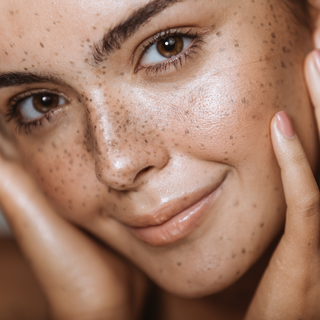For refreshing and rejuvenating your skin, and troubleshooting your skin concerns, some of the most effective exfoliant ingredients are acid-based. In particular, we love alpha-hydroxy acids, and their close relative beta-hydroxy acids, for their efficacy and ability to create real results with your skincare.
But have you ever wondered about the difference between these two staples? And which one is right for your skin type? Here’s what you need to know:
About Alpha-Hydroxy Acids
Since ancient times, botanically-based acids found in fruit and other plants have been used to exfoliate, soften, and smooth the skin. You’ll often find them blended together alongside other active ingredients, and even some physical exfoliants to enhance the effects of a scrub. Common examples of AHAs include glycolic acid from sugar cane, lactic from milk, malic acid from apples, mandelic acid from almonds, and tartaric acid from grapes.
When to use AHAs:
AHAs are beloved for their ability to multitask. In skincare, these acid ingredients work by breaking apart the bonds between dead or unhealthy skin cells, in order to make room for new healthy cells and stimulate cellular renewal processes. For this reason, AHAs are very effective for supporting aging well, and minimizing dryness, dullness and discolouration.
Beta-Hydroxy Acid Breakdown
With a similar, yet slightly different chemical composition that makes it milder than most AHAs, salicylic acid is considered to be in a category of its own, and referred to as being a beta-hydroxy acid, or BHA. Derived from willow bark, sweet birch, and wintergreen, salicylic acid is known for having incredible antiseptic and anti-inflammatory properties, in addition to providing mild exfoliation.
When to use BHAs:
The most common use of salicylic acid is for the treatment of acne, as it works to reduce redness and irritation in inflamed lesions. It can even be helpful in controlling oil production, while also breaking down buildup of the dead skin cells that can congest the pores and contribute to breakout activity. Additionally, in recent years formulas containing a low percentage of BHA have been deemed appropriate for sensitive skin, and look for fragrance free formulations.
Other Important Things to Know
If you’re still having trouble deciding between AHAs and BHA, the good news is that you don’t have to. In your favourite formulas, it is not unusual to see both alpha and beta-hydroxy acids combined for a more comprehensive approach to treating numerous skin conditions. They tend to work very synergistically and produce even better results when used together. Just be sure to always use types of products in moderation, go low % and slow in frequency, as they can be quite potent and irritating to the skin, if used incorrectly.
Stay tuned as you as you know I am always working behind the scenes with our Canadian Chemists and Cosmetic Formulators to bring you the BEST skincare products for long-term skin health!

